Spruce Knob Lake Journal
I sat on my beach chair and sipped ice cold club soda, oh, it is so refreshing!
It was just before 6PM, the day before Memorial Day and I was at Spruce Knob Lake campground. The sky was a little cloudier than I would have liked, but I decided to rest a little bit before going down to the lake.
173 miles to camp. I left home in the morning. It took me forever to get things packed – camping equipment, food, drink, camera equipment, maps and directions. Finally at 10:15 I drove off on this bright sunny day.
I first got on I-66 going west. I cannot count how many times I’d taken this road to go to Shenandoah National Park, but today I just breezed by. Going through Strasburg, before long I crossed the line into West Virginia. I remember these roads, winding down the river valleys and hollows, with glimpses of craggy rock formations on either side.
Soon the road widens and becomes a freeway. This section US-48, WV-55 and WV-259 coincides and it is one of the most delightful roads in the east, I dare day – nicely paved surface, gently graded and curved, generous shoulders and wide median. In some stretches one side of the road gently curves over a deep hollow, offering breathtaking views; in other stretches the road cuts through a mountain, the sheer cliff reveals the folds and faults in the rock formation, giving free geology lessons. To add more to my delight, there are always very few cars on this road. Indeed, it reminds me of the roads in sparsely-populated Canada when we took the trip to Fundy and the Gulf of St. Lawrence two years ago.
The road goes through Mooresfield. I stopped at a McDonald’s for lunch. There were many flies at this restaurant. To my amazement (and amusement), two of the fliers, one on top of another, landed right in front of me on the table. Apparently they were mating. They should have advertised “free insect porn!”, I thought to myself.
Route 28 follows more or less Mill Creek, a tributary of South Branch Potomac River. The limpid and bubbling water easily reminded me of Oak Creek Canyon in Arizona, or Highway 1 to Point Reyes in Marin County … oh, all those places that we have been to!
I arrived at the visitor center at Seneca Rocks at around 1:45PM. Composed of Tuscarora quartzite , Seneca Rocks is the most dramatic rock formation east of Mississippi. Its saddle-shaped peaks rise some 900 feet from the valley floor. Though modest in absolute elevation (just over 2,400 feet), its almost sheer cliffs and craggy contour give it an imposing character. The west-facing rock surface just came into the sun, and there were many clouds, some rather thick, in the sky. I went into the visitor center and talked to a park ranger, who gave me some maps and directions to Spruce Knob Lake Campground. I decided to wait there for some time, half hoping the clouds would be blown off or dissipate. I had taken the hike to the top (actually not the top; only rock climbers can get to the very top, but there is a wooden viewing platform near the top at the end of the hiking trail) 10 years ago; I thought I would take it again the next day on my way back. I waited, leisurely watching the rocks and the rock climbers. The clouds never dissipated, and I finally left at 3:20PM.
Turning off the highway and unto a forest road , I now drove toward Spruce Knob, the highest point in West Virginia (4,863 feet or 1,482 m). The road winds up the mountain and conifers started to appear on the side. For the second time I was reminded of our road trip to Canada two years ago – this part looked similar to the road in Fundy National Park. I half-expected to see a moose crossing the road. The road is paved, but narrow. When a car comes from the opposite direction, we often have to both veer off the road and onto the road shoulder (which is rather slim or nonexistent).
A sign of the Eastern Overlook came up; I pulled off to the overlook. A country couple were hugging and kissing outside their car at the overlook; they were not pleased to see me pulling off. “You two, go get a room”, I yelled at them. Actually I did not say that but just ignored them. Nice view of the lower hills and valley below. I took out my camera and took some pictures. The couple left.
Finally, to the top! I was surprised to see many cars in the parking lot at the summit as the traffic was light going up. A sign commemorates “the Top of Mountain State” (at 4,863 feet or 1,482m). But the walk to the observation tower was rather anticlimactic – the top of the mountain is very flat, the walk is only 900 feet, with no perceptible elevation change. I did not even change to my hiking boots and just wore my sandals. The observation tower has panoramic views, but the sky was overcast, a blue-gray haze hung in the air. An Eastern Towhee, hidden in the spruce nearby, repeated its raspy “drink-your-tea” song. Not to be outdone, an Indigo Bunting also sang its whistling notes incessantly in the distance. How funny, I thought, neither bird had a melodious song, but you could feel their exuberance on the top of the mountain.
The “Whispering Spruce” is a half-mile trail winding through its namesake forest around the summit; I certainly wouldn’t decline such a stroll. Along the trail there were several overlooks, even viewing platforms. One of the spot overlooks a gently sloped hill cleared for homesteads and pasture, almost exactly like a drawing of “the Shire” in the Lord of the Rings. As I walked, I heard the songs of a Wood Thrush. Now that is a melodious song, in fact I think it is the most haunting, ethereal songs of all North America songbirds (save for that of its cousins, the Hermit Thrush, perhaps).
The road to Spruce Knob Lake campground is a dirt road, laden with potholes, some quite large. I drove slowly, carefully negotiating the road, trying to minimize the bumps. Soon a Jeep appeared behind me, following very closely. The tires of my car kicked up a cloud of dirty and loose gravel, yet he kept coming, effectively tailgating me. I tried to drive at my own pace, but in these situations, you inevitably still take the action of the car behind you into your calculus. Around a sharp downward turn, almost 180 degrees, the road widens a little bit, and I slowed down and let him pass. Asshole disappeared quickly (and bumpily) in a yellow-gray haze. After that I drove in peace.
I arrived at the campsite before 5:30PM. My site is near the entrance and I saw my name on the reservation notice on the pole. I parked my car and checked out the site – as expected, a parking spot, a picnic table, a rectangular flat gravelly field for the tent. Awesome, I thought to myself, I would spend a night here.
I walked to the staff’s site and chatted with them, I told them that I paid for the night on the website (“we know”), and asked where the lake was. Just follow the road and you will get to the lake, I was told.
So now I am sitting here, drinking club soda. I decided not to set up tent yet, but just pulled out the beach chair and got a cold drink from the cooler. It was still early, there was plenty of time before dark, so I decided to rest a little bit before going down to the lake.
---
I walked along the road to the lake. At 3,840 feet Spruce Knob Lake is the highest lake in West Virginia. But it really is a reservoir; it came to existence when they built a dam at the headwater of Narrow Ridge, a mountain creek. I suspect before the dam was built, this area was swampy and reedy. Now that it is officially a “lake”, WV DNR (Department of Natural Resources) stocks it with trout for recreational purposes. So it is hardly “wilderness”, that’s for sure.
Back to camp after 7PM, I pitched the tent and boiled some water and made coffee. The campground is quieter than I expected, this being a holiday weekend. I think campgrounds in national forests are generally less visited by people, whereas in national parks, starting from Memorial Day, the campgrounds can be very crowded and festive. I could hear Ovenbirds singing in the woods. What more can you ask for?
Since I was on a solo trip, I kept food items to a minimum: just cup noodle and boiled eggs, and some snacks and a few apples. It’s the best food I have had in a long time. It’s always the best food when it’s eaten in the mountains.
I brought two books with me: “Einstein's Dice and Schrödinger's Cat” by Paul Halpern and “Death of a Hornet” by Robert Finch. I got into the tent and put on my headlamp and started reading. The Halpern book is a fascinating read, but the rudimentary spelling and grammar errors are a little irksome sometimes. Surely he had a spellcheck in his favorite word processor program? The Robert Finch book I had read a couple of times before, but it is always a solace to read his writing, and especially so in camp.
Finally back into my tent again. There was nothing to do but sleep. I got into a state where I did not know I was really asleep or still half-awake. Then the wind started. At first, I heard it at the top of the trees, it seemed so distant. Then, after some time, the wind seemed to start to descend, and the rain cover of my tent started to flutter. The wind was neither vicious nor gentle; it was the kind of persistent and permeating wind. It sounded like every leaf in the woods was trembling. In a kind of dreamy but restless state I spent the rest of the night.
---
By golly the Overbird was loud! It sounded like it was right outside my tent. And the woodpecker (which kind I could not tell): it banged heavily on a tree trunk. I woke up. It was not even 6AM yet.
I went outside my tent. The day was breaking already. A Scarlet Tanager flew above my campsite. “Sweet”, I thought, not often one wakes up and sees a Scarlet Tanager. Then it perched on a tree branch right above my head. This begged for pictures. I quickly opened the trunk of my car and got out my camera and snapped a few pictures.
I boiled some water to make coffee. My eyelids were heavy; two cups of coffee helped somewhat. It was getting brighter now and I knew the light must be good at the lake. I made oatmeal and ate it with a boiled egg, then headed to the lake.
As I walked on the stairs toward the lake, I heard the persistent “yea-PEE” calls of Alder Flycatchers. Actually, at the time I thought they were Willow Flycatchers. Both Alder and Willow Flycatchers belong to the genus of Empidonax, or “Empids”. They are notoriously similar to each other. The only reliable way, we are told, to distinguish them is by listening to their calls. I had not so far definitively identified either species, and I studied their calls on the internet before, yet I could not memorize their calls. The “official” transcription of Alder Flycatcher’s song is “f-bee-oo” or “ree-BEE-a”, whereas that of the Willow Flycatcher is “fitz-bew” or “rrritz-bew”. Got the difference? And this is the most reliable way (they look practically identical). Trying to describe bird songs using onomatopoeia of human languages is more often pathetic than not.
I returned to camp and quickly unpitched my tent, cleaned up camp and packed everything into the car. The riotous chorus of the birds at daybreak had died down a bit, and the woods were just getting bright, now that the sun was high. I left just after 9AM.
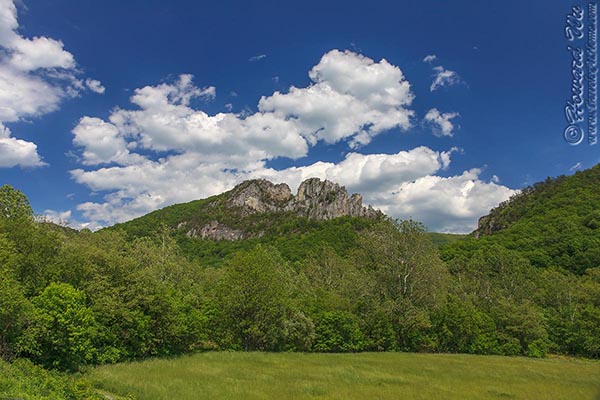
Seneca Rocks
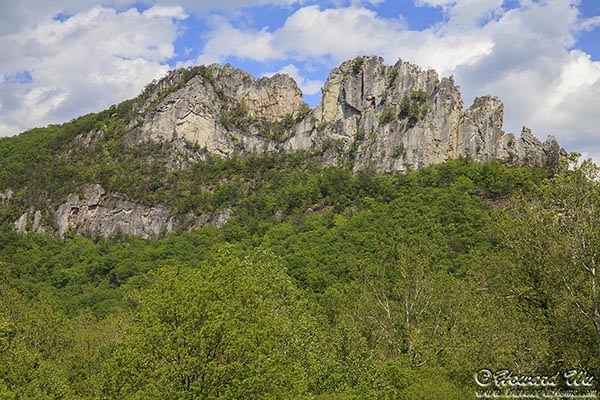
Seneca Rocks
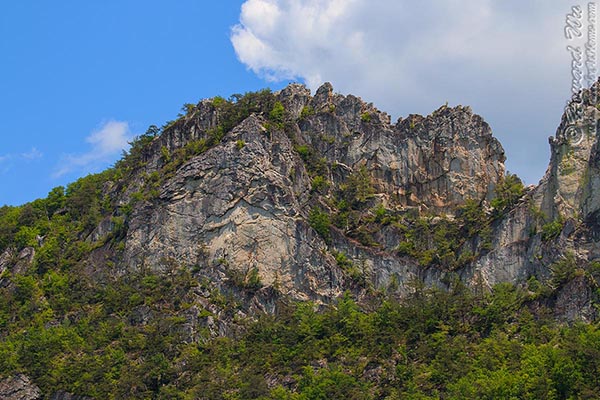
Seneca Rocks
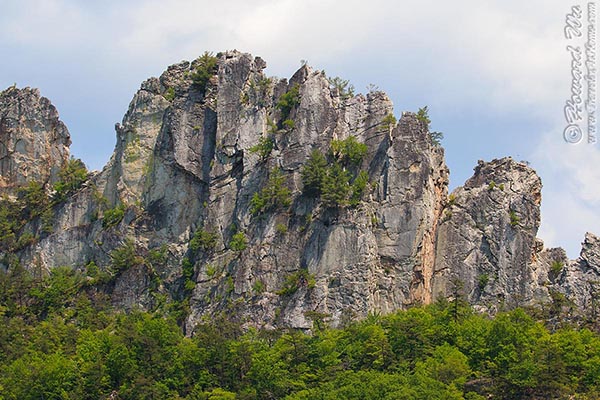
Seneca Rocks
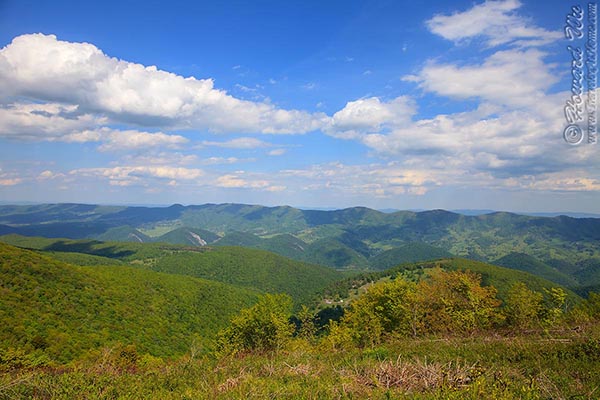
View from the Eastern Overlook of Spruce Knob
But the setting is lovely – the lake is surrounded by gentle hills that are covered with a mix of conifers and hardwoods. Technically we are still in spring, and at this elevation the deciduous trees still have their tender, yellow-green leaves, contrasting with the dark needles of the conifers. I walked down to the parking lot, then across the dam and counterclockwise around the lake. There were many people fishing there, most lazily sitting in their chairs on the bank, some floating in a boat in the middle of the lake. One woman waded into the lake, fly-fishing style, but in jeans and not hip boots.
There were stands of fiddlehead ferns in the swampy areas around the lake. These dedicate plants were just sending out their furled fronds, covered with fine, filamental hair. A Dark-eyed Junco flitted in the trees. Unlike most other migratory birds, which employ a latitudinal migration strategy – that is, they migrate from north to south and back, juncos migrate attitudinally – that is, they spend their winter months in the lowlands and migrate to their breeding grounds at higher elevation in spring and summer. To me who lives near the coast, they are decidedly a winter bird, but in summer I always expect to find them in the mountains.
A sandpiper on the shore of the lake caught my eye. Its bobbing and wagging tail gave it away – this was a Spotted Sandpiper. They were also on their (latitudinal) migration path. West Virginia is at the southern edges of their breeding range, it is possible that they might settle down here. This one certainly had its breeding plumage, with the dark spots showing on the chest (these spots disappear in the winter, adding much to the confusion of identifying sandpipers).
There were some warblers singing in the trees, but I could not see them. My skills at identifying birds, especially warblers, by ear are still poor. I did see a Cedar Waxwing and a Red-winged Blackbird though.
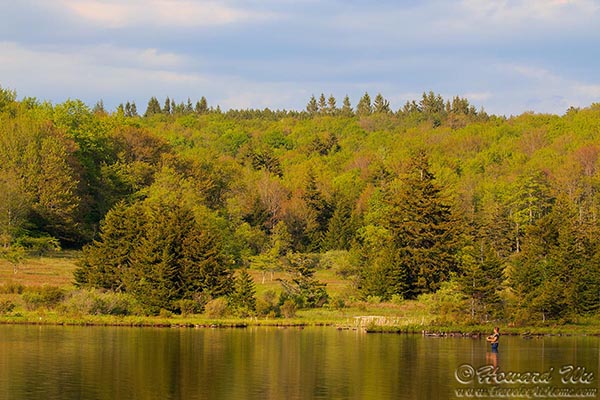
Spruce Knob Lake -- "the lake is surrounded by gentle hills that are covered with a mix of conifers and hardwoods"
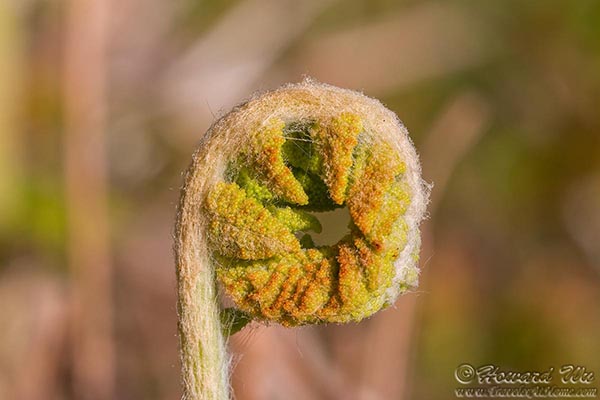
Fiddlehead Fern
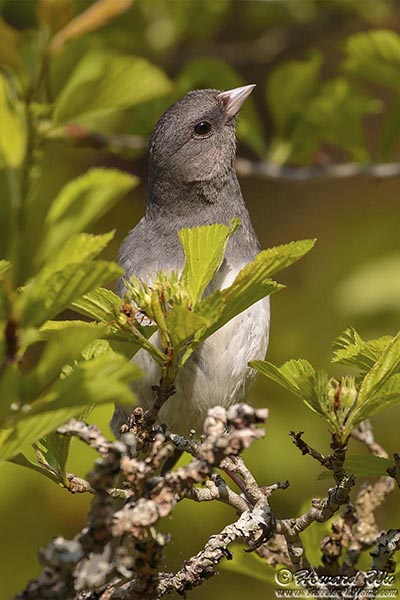
Dark-eyed Junco
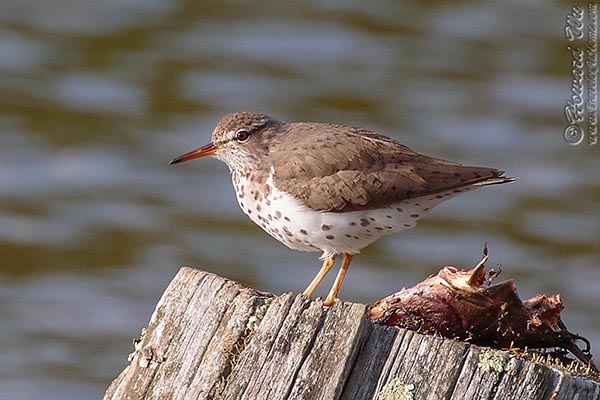
Spotted Sandpiper
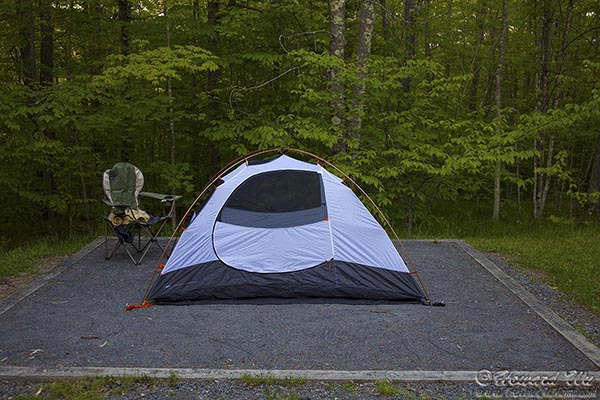
Tent -- "The campground is quieter than I expected"
At around 10PM or so I went to the outhouse. I looked up and there were so many stars in the sky! I did not plan to take night pictures, but I was prepared (which is to say I brought the right photo equipment with me). Earlier, I had concern about the clouds, but now the sky looked clear. I decided to give it a try.
I walked again to the lake. I wore my headlamp backwards so cars behind me could see me, and used a powerful handheld flashlight for illuminating the roads in front of me.
Roads take a decidedly different character in the dark. During the day this was just a forest road, lined with trees but not much different than any roads that wind through the woods. At night, the trees on each side looked taller and more imposing, the gentle bend toward the lake seemed to extend into the unknown. Insects and frogs were buzzing, chirping, calling, adding mysteries to the atmosphere. A very large toad sat in the middle of the road. I shone my flashlight on it but it ignored me. I hope it would move at some point, as there were still occasionally cars going to the lake, even at this hour.
But down at the lake there was no mystery -- there were quite a few night fishermen there, you could almost say it was crowded. A waxing crescent moon hung in the southeastern sky, pale and luminous. Jupiter was near the moon, then further to the west, Venus. My goodness, it was so bright. I think in intensity it is brighter than the moon, almost piercingly blinding (now that my eyes were adjusted to the darkness). And it is large, it almost seemed like a disk rather than a dot to me. Together -- the moon, Venus, perhaps Jupiter to a lesser extent -- cast a soft and milky veil on the grassy surface of the dam and the swampy area below it.
I set up my tripod and camera to take some pictures. In the dark it was very difficult to focus -- I could barely see anything in the viewfinder. I then realized, I could use the fishermen's lights or the moon to focus, then re-compose the picture. There were still many stars in the sky, definitely more so than in the light-polluted sky in the suburbs, but the bright moon and planets washed out any trace of the Milky Way. The sky was also not free of manmade artifacts -- blinking jets, and a faint aura of light from the valley below.
After spending half an hour or so and capturing some half-decent pictures (not as good as I had hoped, but probably the best I could do under such circumstances), I wrapped up my equipment and started walking back. A large moth fluttered by the road side. It was brownish in color with large concentric spots on the wings. I would have to put down everything, take out my camera, mount the flash to take a picture. I decided I was too tired for that, so I just watched the moth for a few seconds.
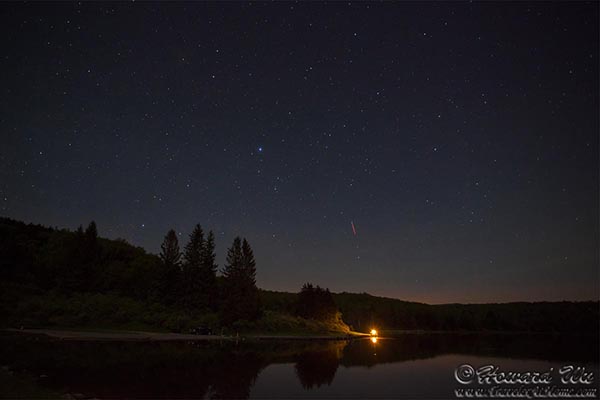
Spruce Knob Lake at night -- "The sky was also not free of manmade artifacts"
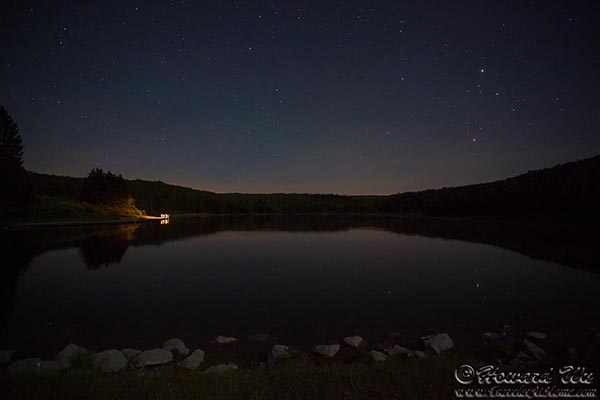
Spruce Knob Lake at night -- "The sky was also not free of manmade artifacts"
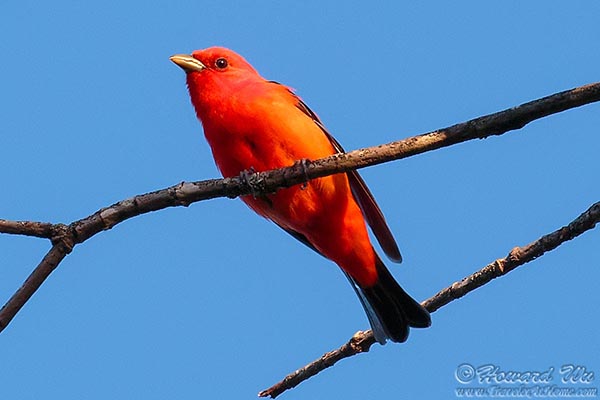
Scarlet Tanager -- "This begged for pictures"
The birds were not the only thing that caught my attention though. Hanging over the lake is a thin layer of mist, which was rapidly disappearing, as the sun peered over the hills in the east. Mornings are when birds are most active. A few Canada Geese were already quarrelling in the parking lot, and several robins were singing and foraging in the bushes.
I decided to do something different than the day before: instead of going counterclockwise, this time I went clockwise around the lake! The creek that was dammed to form the “lake” runs east-west, so the northern and southern banks are dry, man-made banks impoundment. The western (downstream) end is the dam, the eastern end (upstream) is more swampy, then gradually changes to thickets and woods farther away from the lake.
I finally saw the buzzing warbler that I heard the day before on the top of a tall spruce tree – it was a Magnolia Warbler, in beautiful breeding plumage, with a dark mask and white “eyebrow”, and brilliant yellow breast with prominent black streaks. A few fishing boats serenely floated on the water. I saw the sandpipers again, flying along the lake shore, pecking and probing in the mud. Reaching the thickets at the eastern end, a singing Gray Catbird caught my attention. Part of the thrasher family (the same family that also has the Northern Mockingbird), Gray Catbirds also have a repertoire of songs, mixed with its whiny “meow, meow” calls that give them their name. They are not the prettiest birds and their song not the most melodious, but I like them. There is one pair that nest outside my kitchen window the last few years, I wonder how they are faring this year.
The swampy area below the dam was a live with birds: American Robins, Eastern Towhees and Alder Flycatchers. Here the creek cuts through a valley, with sloping hills on either side forming a V-shaped portal to the beyond. I scanned the trees and shrubs for birds, but they were mostly invisible. Finally I spotted a flycatcher sitting on top of a Fire Cherry, nonchalantly issuing its raspy little song. This was when I finally definitively identified it, and it would be my only new bird of the trip.
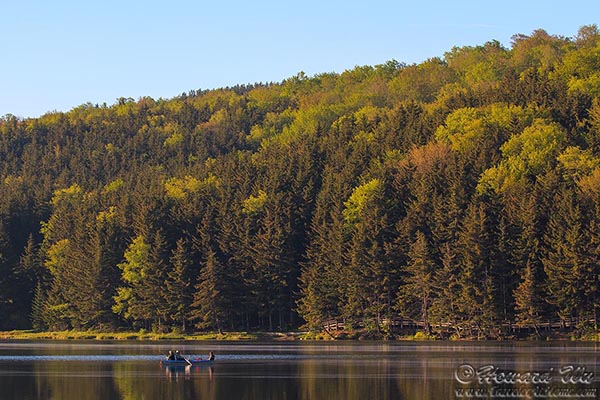
Spruce Knob Lake
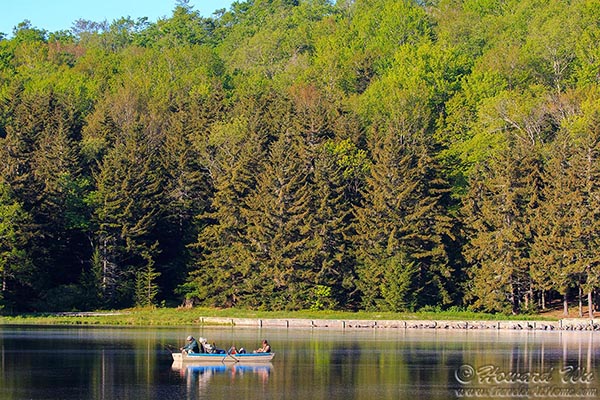
Spruce Knob Lake
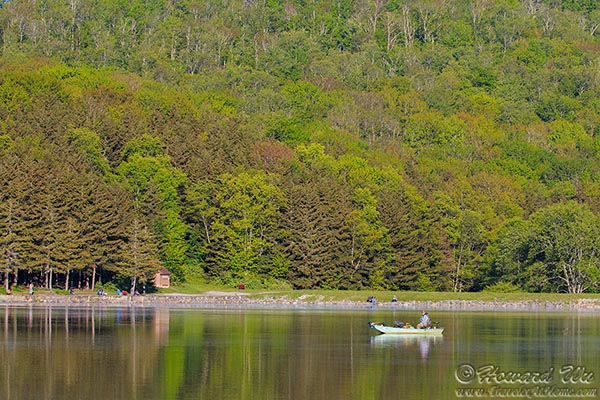
Spruce Knob Lake
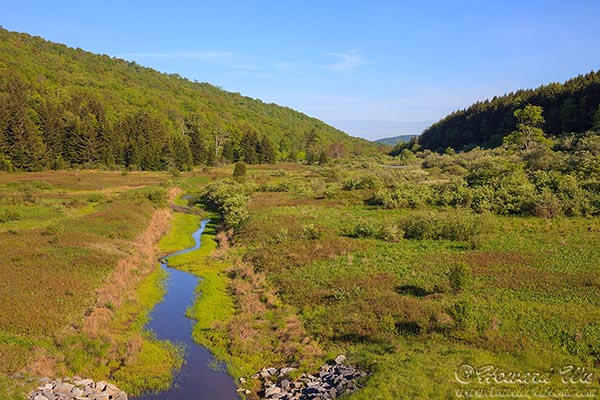
Narrow Ridge (name of the creek) -- "The swampy area below the dam was a live with birds"
The drive back along the dirt road was completely unharassed – there was no incoming traffic whatsoever, and for more than half of the way there was also no car behind me. Then suddenly a big black bear hurriedly ran across the road to the slope on the left. It was a big and strong beast, most certainly an adult male. I stopped the car and looked over toward the slope, hoping to get a glimpse of it again, but it disappeared in the forest. Always exciting to see a bear, especially when you are safely in the car! This is when I noticed another car came bumping up and down the road behind me. But its pace was slower than mine, so I was never rushed.
In contrast to the day before, the weather was delightful when I reached Spruce Knob again – there are smudges of clouds near the horizon, but the sun was shining bright. As I walked toward the observation tower, a couple walked by and the woman said “Be careful with the flies!” There were a lot of flies under the spruce trees next to the trail, I think these were common green bottle flies whose larvae (maggots) feed on carrion (adults do not eat), so there must have been a dead animal somewhere. But there were harmless enough, if a little annoying.
On top of the world again! For some time I was the only one there. All the rolling hills and rugged ridges were below me. Spring was at its last leg now, but at some of the higher slopes and peaks there were still smudges of the light yellow-green of new leaves. The day was getting hot, and I had to leave soon, but for a moment, I tried to take it all in. I took the Whispering Spruce Trail again, stopping at every overlook along the way. What does it mean by being a traveler at home? It is this: every trip, near or far, is once-in-a-lifetime. Spruce Knob is just over 170 miles from home, surely if I want I can drive here any weekend and spend a night in one of the campsites, or I can even drive back on the same day. But will I? Truth is, having lived in Virginia for more than a dozen years, I have been to Seneca Rocks just once, and this was my first time to Spruce Knob. There are other entanglements of life, and there are other places. Every trip is unique; even if I go back to the same places again, they will change, and I will change. Every moment is to be savored.
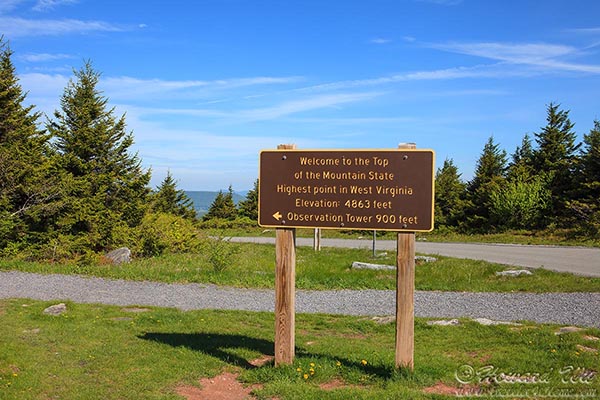
Spruce Knob -- " A sign commemorates 'the Top of Mountain State'"
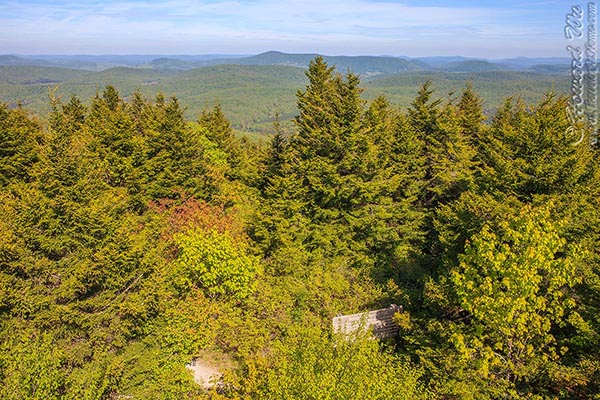
View from Spruce Knob
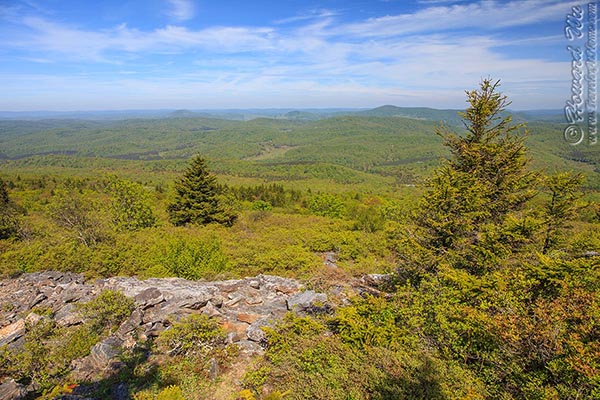
View from Spruce Knob
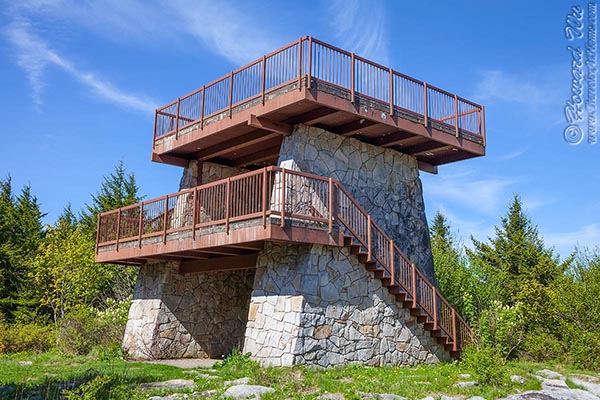
Spruce Knob Observation Tower